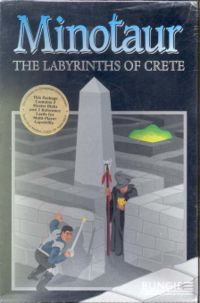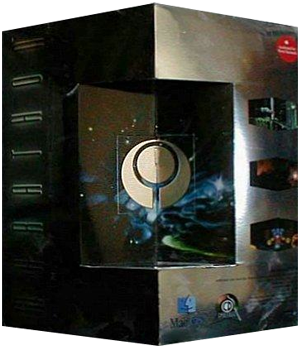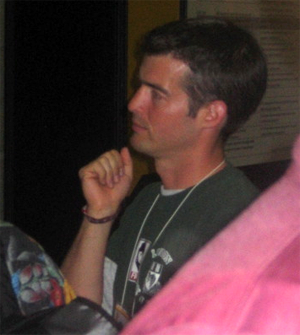
Myth is a series of real-time tactics video games for Microsoft Windows and Mac OS. There are three main games in the series: Myth: The Fallen Lords (1997), Myth II: Soulblighter (1998), and Myth III: The Wolf Age (2001). The Fallen Lords was developed by Bungie, and published by Bungie in North America and Eidos Interactive in Europe. Soulblighter was also developed by Bungie, and was published by Bungie in North America and GT Interactive in Europe. The Wolf Age was developed by MumboJumbo, and co-published by Take-Two Interactive and Gathering of Developers for Windows and by Take-Two and MacSoft for Mac.

The Marathon Trilogy is a science fiction first-person shooter video game series from Bungie, originally released for the Classic Mac OS. The name of the series is derived from the giant interstellar colony ship that provides the main setting for the first game; the ship is constructed out of the Martian moon Deimos. The series is often regarded as a spiritual predecessor of Bungie's Halo series.

Halo: Combat Evolved is a 2001 first-person shooter video game developed by Bungie and published by Microsoft Game Studios for the Xbox. It was released as a launch game for Microsoft's Xbox video game console on November 15, 2001. The game was ported to Microsoft Windows and Mac OS X in 2003. It was later released as a downloadable Xbox Original for the Xbox 360. Halo is set in the twenty-sixth century, with the player assuming the role of the Master Chief, a cybernetically enhanced supersoldier. The Chief is accompanied by Cortana, an artificial intelligence. Players battle aliens as they attempt to uncover the secrets of the eponymous Halo, a ring-shaped artificial world.

Star Wars: Dark Forces is a first-person shooter video game developed and published by LucasArts. It was released in 1995 for MS-DOS and Macintosh, and in 1996 for the PlayStation. The story is set in the fictional Star Wars expanded universe and begins shortly before the original Star Wars film, before flashing forward to a year after the film's events. The game's protagonist and playable character is Kyle Katarn, a mercenary working on behalf of the Rebel Alliance who discovers the Galactic Empire's secret Dark Trooper Project, which involves the development of a series of powerful new battle droids and power-armored stormtroopers.

Myth: The Fallen Lords is a 1997 real-time tactics video game developed by Bungie for Windows and Mac OS. Released in November 1997 in North America and in February 1998 in Europe, the game was published by Bungie in North America and by Eidos Interactive in Europe. At the time, Bungie was known primarily as developers of Mac games, and The Fallen Lords was the first game they had developed and released simultaneously for both PC and Mac. It is the first game in the Myth series, which also includes a sequel, Myth II: Soulblighter, set sixty years after the events of the first game, also developed by Bungie, and a prequel, Myth III: The Wolf Age, set one thousand years prior to the events depicted in The Fallen Lords, and developed by MumboJumbo.

Myth II: Soulblighter is a 1998 real-time tactics video game developed by Bungie for Windows and Mac OS. Published by Bungie in North America and by GT Interactive in Europe, the game was also ported to Linux by Loki Entertainment. It is the second game in the Myth series, and a sequel to Myth: The Fallen Lords. In 1999, an expansion pack, Myth II: Chimera, was released. Developed by the Badlands mapmaking group, in association with Bungie, Chimera is set ten years after Soulblighter. Originally released as a free download, Chimera was later published by Bungie as part of the Total Codex bundle, incorporating it into the official Myth canon. In 2001, a third Myth game was released, Myth III: The Wolf Age, set one thousand years prior to The Fallen Lords, and developed by MumboJumbo.

Minotaur: The Labyrinths of Crete is a 1992 role-playing adventure video game for Macintosh by Bungie; produced by Jason Jones and Alex Seropian.

Dark Castle is a 1986 platform game for Macintosh that was originally published by Silicon Beach Software. The original game was designed and animated by Mark Pierce and programmed by Jonathan Gay with Real Sound by Eric Zocher. In Dark Castle, a young hero named Duncan tries to make his way to the evil Black Knight, dodging objects as well as solving occasional puzzles.

Alexander Seropian is an American video game developer, one of the initial founders and later president of Bungie, the developer of the Marathon, Myth, and Halo video game series. Seropian became interested in computer programming in college and teamed up with fellow student Jason Jones to publish Jones's game Minotaur: The Labyrinths of Crete. The two became partners, and Bungie grew to become the best-known Apple Macintosh game developer before being bought by Microsoft in 2001.

Realmz is a fantasy adventure and role-playing video game first developed and published by Fantasoft in 1994 for the Apple Macintosh as shareware. Fantasoft released a Microsoft Windows-compatible version in 1999, and a science fiction role-playing game based on the Realmz engine, titled New Centurions, in 2001. Realmz was originally written by Tim Phillips on a Macintosh IIsi; he also wrote four game scenarios, including the introductory scenario "City of Bywater". Other original scenario contributors were Jim Foley and Sean Sayrs.

Marathon Infinity is a first-person shooter video game, the third in the science fiction Marathon Trilogy by Bungie. The game was released on October 15, 1996 and included more levels than its predecessor Marathon 2: Durandal. These levels were larger, and formed part of a more intricate plot. Marathon Infinity, unlike Marathon 2, was originally released only for the Apple Macintosh. However, Bungie released the source for Marathon 2 in 1999, allowing the development of the open-source multiplatform Aleph One engine that is also compatible with Infinity. In 2005, Bungie released the trilogy to the public as freeware, allowing the games to be freely downloaded. In 2011, Bungie released the source code for Marathon Infinity itself, preceding an official Aleph One-based port for iOS the next year that is available free.

Marathon is a first-person shooter video game developed and published by Bungie, and released in December 1994 for the Apple Macintosh. The game takes place several centuries into the future in outer space and sets the player as a security officer attempting to stop an alien invasion aboard a colony ship named the Marathon.

Lode Runner 2 is a puzzle-platform game released in 1998 for Mac OS and Microsoft Windows. It is a sequel to Lode Runner and its remakes. Like the earlier Lode Runner's Rescue, Lode Runner 2 has isometric-perspective 2D graphics. It was developed by Presage Software and distributed by GT Interactive for Microsoft Windows and MacSoft for the Macintosh.

Jason Jones is an American video game developer and programmer who co-founded the video game studio Bungie with Alex Seropian in 1991. Jones began programming on Apple computers in high school, assembling a multiplayer game called Minotaur: The Labyrinths of Crete. While attending the University of Chicago, Jones met Seropian and the two formed a partnership to publish Minotaur.
Mac gaming refers to the use of video games on Macintosh personal computers. In the 1990s, Apple computers did not attract the same level of video game development as Microsoft Windows computers due to the high popularity of Microsoft Windows and, for 3D gaming, Microsoft's DirectX technology. In recent years, the introduction of Mac OS X and support for Intel processors has eased porting of many games, including 3D games through use of OpenGL and more recently Apple's own Metal API. Virtualization technology and Boot Camp also permit the use of Windows and its games on Macintosh computers. Today, a growing number of popular games run natively on macOS, though as of early 2019, a majority still require the use of Microsoft Windows.

Battle-Girl is a 1997 multidirectional shooter video game developed by Ultra/United Games and originally published by Power Media for the Macintosh. In the game, players assume the role of the titular character taking control of her Soyuz 1183-A BattleCraft to save the Great Machine by eradicating malicious programmers released by Terminus, a weapon of Chaos. Its gameplay uses a two-joystick configuration reminiscent of Robotron: 2084.

A first-person shooter (FPS) is a video game centered on gun fighting and other weapon-based combat seen from a first-person perspective, with the player experiencing the action directly through the eyes of the main character. This genre shares multiple common traits with other shooter games, and in turn falls under the action games category. Since the genre's inception, advanced 3D and pseudo-3D graphics have proven fundamental to allow a reasonable level of immersion in the game world, and this type of games helped pushing technology progressively further, challenging hardware developers worldwide to introduce numerous innovations in the field of graphics processing units. Multiplayer gaming has been an integral part of the experience, and became even more prominent with the diffusion of internet connectivity in recent years.
Bungie, Inc. is an American video game company based in Bellevue, Washington, and a subsidiary of Sony Interactive Entertainment. The company was established in May 1991 by Alex Seropian, who later brought in programmer Jason Jones after publishing Jones's game Minotaur: The Labyrinths of Crete. Originally based in Chicago, Illinois, the company concentrated on Macintosh games during its early years and created two successful video game franchises called Marathon and Myth. An offshoot studio, Bungie West, produced Oni, published in 2001 and owned by Take-Two Interactive, which held a 19.9% ownership stake at the time.
Pool of Radiance is a series of role-playing video games set in the Forgotten Realms campaign settings of Dungeons & Dragons; it was the first Dungeons & Dragons video game series to be based on the Advanced Dungeons & Dragons rules.

















